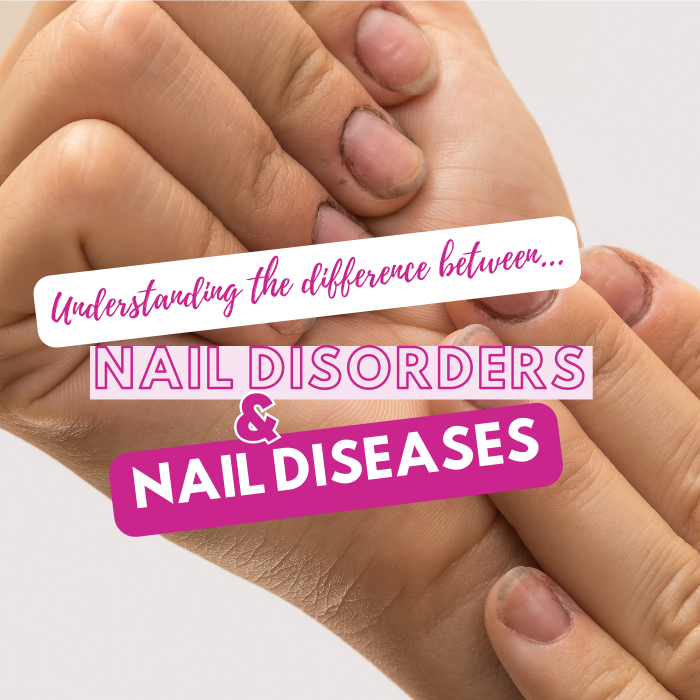
Let's be clear: as a Nail Technician in the UK, you're not qualified to make diagnoses, only to offer recommendations. When in doubt, the rule of thumb is to direct your clients to their GP and avoid any treatment.
Nail Disorders
Nail disorders are treatable conditions that can stem from various internal and external factors. Most people will experience one or more of these issues at some point.
Examples of nail disorders include:
- Beau's Lines: These are wavy horizontal ridges across the nail plate, often caused by illness, medication, or heart disease. Light buffing can help improve this condition.
- Furrows: Ridges from the matrix to the free edge, often caused by arthritis, incorrect removal of nail extensions, or damage to the matrix. Light buffing can help improve this condition. Consider using a clear or light polish to conceal the ridges.
- Leukonychia: White spots on the nail plate, commonly mistaken for a calcium deficiency but actually caused by minor trauma to the nail. White spots will eventually grow out, so handle the nail with care to avoid further damage. Over-filing when blending nail extensions is a common cause.
- Eggshell Nails: These are thin, curved nails that are fragile. Improper diet and severe medication can lead to this condition. In such cases, it's best to keep the nails short and avoid putting too much pressure on them.
- Hangnail: A small tear or split in the cuticle, which can be removed with cuticle nippers during a manicure. Consistent nail treatments are necessary to improve dry skin conditions.
Nail Diseases
Nail diseases are more serious and, if left untreated, can lead to deep infections or even permanent damage to the nail. If you suspect a client has an infection or any of the following nail diseases, it's crucial to refer them to a GP for proper treatment. Do not proceed with a nail treatment until they have a GP referral letter confirming they are safe to do so.
Examples of nail diseases include:
- Infection and Inflammation: The nail or finger may appear red and swollen, indicating a bacterial infection.
- Atrophy: This occurs due to injury or disease, leading to the wasting away of the nail plate.
- Hypertrophy: A fungal infection that causes the nail plate to become excessively thick and overgrow at the side walls. Without infection, regular buffing can help thin the nail plate. This condition can be hereditary.
- Whitlow: A bacterial infection, often arising from infected hangnails, which can result in permanent damage to the nail plate.
- Warts: A viral infection that manifests as lumps on the hands and fingers. They are highly contagious and should be referred to a GP immediately.
- Ringworm: A fungal infection, often presenting as white patches on the nail plate due to rot.
- Onychoschizia: An injury or disease that can cause the nail plate to lift away from the cuticle as a new nail grows, pushing the old nail plate off. The nail must fully regrow before any treatments are carried out.
- Onycholysis: An infection where trauma or psoriasis causes the nail plate to detach from the nail bed, starting at the free edge. Handle with care, as the nail can easily rip off. This often occurs after incorrect or at-home removal of nail extensions.
Consider creating a reference book on nail diseases and disorders with images to help recognize these conditions. Due to the lack of regulations in the nail industry, many Nail Technicians lack the qualifications and knowledge to spot nail diseases, which can lead to infections spreading. As a responsible nail technician, it's your duty to advise and improve your client's nail condition. Make sure you understand the distinction between nail disorders and diseases, and when in doubt, don't hesitate to seek advice from a GP.

Questions:
- How Do I Get More Clients For My Nail Business?
- How Much Should I Charge Clients For My Nail & Beauty Services? A Practical Guide for UK Entrepreneurs
- Am I Using The Right Makeup For My Skin Undertone?
- How Do I Attract Customers to a Nail Salon?
- Do I Need a Business Degree to Start a Nail & Beauty Business?
- Are Acrylic Nail Fumes Dangerous?
- How Do I Market Myself As a Nail Technician?
- What Are The Most Essential Marketing Tools For A Nail & Beauty Business?
- What Is Your Favourite Marketing Tool For Nail & Beauty Salons?
